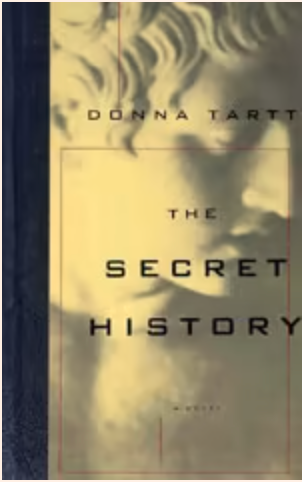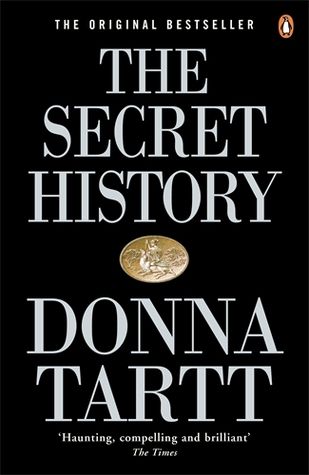So begins The Secret History, the debut novel that launched Donna Tartt into the literary stratosphere 30 years ago this month. An instant classic, it is one of those rare books that gripped readers from its intense first line and has held them in its thrall ever since. I know the feeling personally — I have read The Secret History every year for the last 30 years. Yep, you read that right. And I plan to keep reading it every year until I die. (Wow, that sounded really intense, but I meant it in the best way. Like, “I’m gonna love on this book until my death!”) For those of you who are unfamiliar with the plot of The Secret History, let me give you a not-so-brief overview. It’s about a high school graduate named Richard in California 1983. He’s dissatisfied with life, kind of a lonely only child, and not really attached to anything in his town, including his parents. Just as Richard is becoming resigned to the fact that he’s going to keep living an uninteresting existence in California, he sees a brochure for Hampden College in Vermont. A liberal arts college on the other side of the country, where no one knows him, and where he might actually get to experience the changing of seasons, is exactly what Richard thinks he needs. So with a lot of effort, he transfers schools. Richard is immediately enthralled with Hampden College. He is from a poor family, but the small campus is populated with the teenagers of some of the wealthiest families in the country. Everyone seems beautiful and interesting to him. Particularly the group of classics students: Henry, Francis, Bunny, and the twins, Charles and Camilla. (Yes, really. Keep in mind the publication of the book predates Prince Charles and Camilla.) On a campus of snobby elites, the Classics group is considered the most exclusive. The class is led by their aloof instructor, Julian. Richard, who has actually studied Ancient Greek, is told the class is full and he can’t participate. But through a series of events, Richard manages to infiltrate their tiny circle and becomes enamored with the other five students. But friendships become strained when something bad happens with the group. Something REAL bad. And then Bunny decides to blackmail the group. So they kill him. RECORD SCRATCH Wait, did I just spoil The Secret History for you? Nope, not at all. If you remember back to the first sentence: “The snow in the mountains was melting and Bunny had been dead for several weeks before we came to understand the gravity of our situation.” One of the amazing marvels that Donna Tartt pulls off with this book is telling readers exactly who is dead, who did it, and why. She does it on the very first page, and then has you flipping pages to find out just what happened. For me, the first time I read it, it was just about the most exciting thing I had read in all my 16 years. Let me take you back to September of 1992. My mother used to work at a bookstore in town, and I would go there after school and straighten the shelves. In return, the owner would let me pick out a magazine to take home. I would always be sure to get that month’s Vanity Fair. I’d read it cover to cover, even if I wasn’t interested in some of the articles, because it seemed so glamorous and different than my own life. In the September 1992 issue, I came upon a feature on Donna Tartt and the release of The Secret History. She was in her late twenties then, and photographed posing with her pug. (R.I.P. Pongo.) I thought she looked a lot like Sherilyn Fenn on Twin Peaks, especially when I saw her author photo in the back of the book. She looked so stylish and ethereal. And a book about murder and secrets among teenagers, written for grown ups? I knew I had to read this book. It would be a logical step up from the murder and secrets among teenagers written for teenagers that I normally read. Usually by Christopher Pike. (No shade to Christopher Pike. His books are awesome and I still occasionally read them.) As luck would have it, my mother also worked at the town library. (Yep, she locked down all the book jobs in our area. Now you understand why I am like this.) The Secret History had been added to the new release shelves and I was the second or third person to check it out. I read it so fast, staying up all night to finish it, and immediately declared it the best book I had ever read. What appealed to me? I could really relate to Richard, for starters. As a kid in a poor family in the wealthiest town in our state who couldn’t wait to get away, I knew what it was like to envy the privileged kids. I knew what it was like to be on the outside, listening to all the beautiful people talk about parties and vacations and college plans. Unlike Richard, I did not belong to those groups. (I also didn’t get very far away — a whole seven miles, lol.) I felt very adult reading The Secret History. It all seemed so romantic to me. Living away from your parents, where nobody knew you, you could remake yourself. And there was the partying, and doing drugs, and making such good friends that you would do anything for them, even murder. (Yes, I know these things are wrong now, but I was a teenager when I first read it, and given to dramatics.) If this was what being on your own was going to be like, I couldn’t wait to get started! I read the book two more times that fall (so technically I have read it 32 times, for you keeping score at home.) And then I read it again in February of 1993, and for some reason that’s when I decided I wanted to read it every February. And so I have. What I have learned is there is something beautiful about revisiting a work of art that was/is so important to you. I discovered that different sentences stood out to me as I got older. I underlined the hell out of the first copy I owned. Alas, it was lost in the 2003 Great Motor Oil Spill In the Trunk of My Car. (R.I.P. first copy.) It’s not just the sentences I love that have changed for me, as I have aged, it’s the book itself. I thought these kids were so cool when I was young. Now I’m 46, and the last several years when I read it, I’m like, “Where are their parents?!?” I no longer think the partying and drug use and murder sound romantic. I was a little in love with the broody Henry (which could explain my past questionable relationship choices.) Now I recognize that Henry is an asshole and a psychopath. Run far away from the Henrys of the world. I love The Secret History so much that I will read any book that is compared to it. I will tell you, in the past 30 years, I have read dozens and only found two that are worthy of the comparison: The Orchard by David Hopen, and I Have Some Questions for You by Rebecca Makkai, which comes out in February of 2023. It’s often imitated, never duplicated, as the saying goes. That’s not to say that some of those other books I read weren’t good. I just didn’t think they were Secret History-good. It takes more than a murder in a school setting. Publishers love to slap a Secret History comp on any book set at college like they love to slap Gone Girl on any thriller with a twist. (I jest, but I still pick up every single one, so it’s proof it works.) It broke my heart a little many years ago when I realized it’s no longer my favorite book. I can’t even definitively pick one single favorite anymore. But The Secret History has certainly been the most important to me. Reading has saved my life again and again, and The Secret History certainly played a big part in it. I wish I could retroactively send you all back to pick out one book you would like to read every year of your life, so you could know what it’s like to have something become so ingrained in the fabric of your being. Maybe you should start a reading tradition that is all your own. Maybe try The Secret History. For more Donna Tartt and dark academia books, check out Donna Tartt; A Reading Pathway, 8 Books To Read If You Loved The Secret History, and 10 Queer Dark Academia Novels to Obsess Over.


